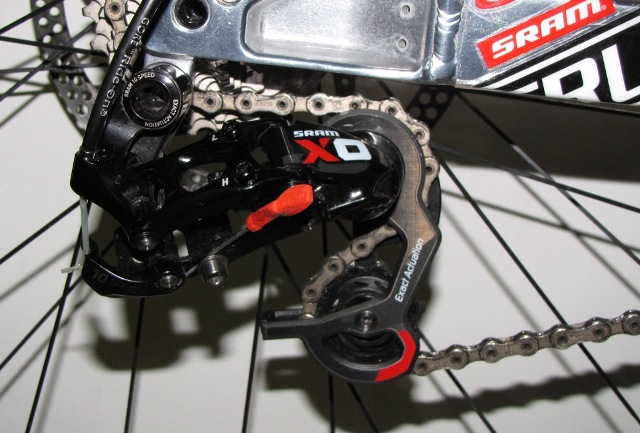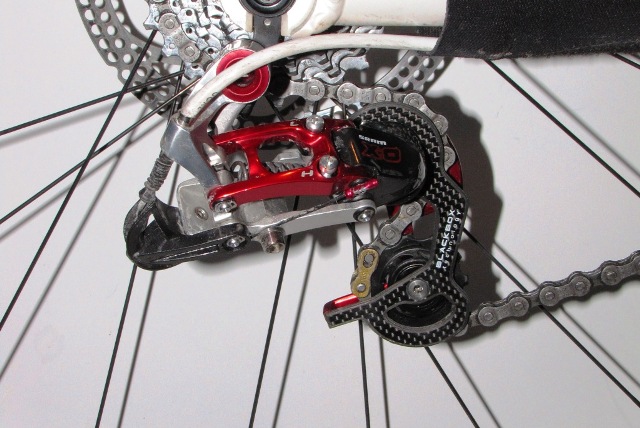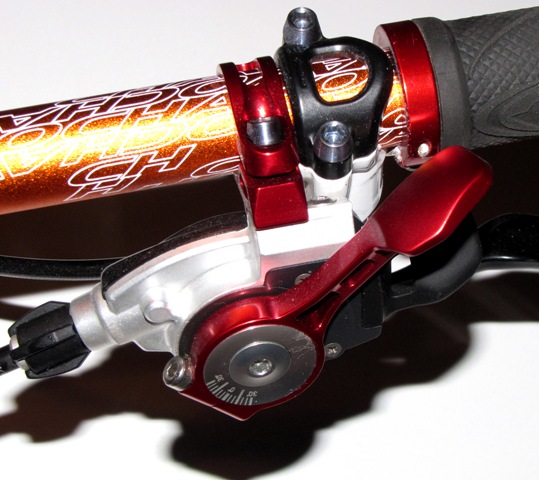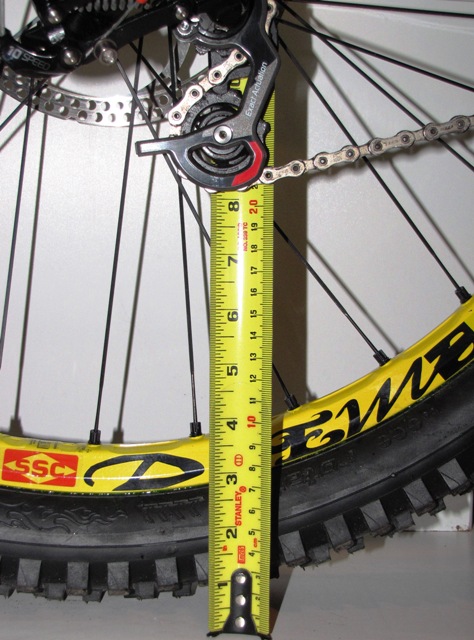For 2011, SRAM is offering 10spd drivetrains throughout the line but that doesn’t mean they’ve dropped the 9spd option and for good reason – the nine speed drivetrains still work great. Choosing the best option is really about what you want to get out of your bike.
Usually whenever people talk about drivetrains they’re talking about both front and rear systems (2×10, 3×9, etc.). But what about drivetrains for slopestyle bikes? You know, those over-sized freeride and downhill mountain bikes that mostly just go down the hill.
For those who aren’t familiar, the term freeride means to make it down a hill on a bike with no rules and no set course using the most creative lines possible. Today’s freeride bikes are pure art with about 7 inches of travel yet they’re still capable of responding to tight and twisting turns. Because freeride bikes mostly ride downhill they typically don’t need a front derailleur and feature a beefed up chain retention system around the crank. So the driveline is usually a 1×9 set up – but what about 1×10?
Well to explore the differences, I installed the 2011 9spd X0 and the 2011 10spd X0 on my Opus Nelson and Banshee Legend II. No front derailleurs allowed – just a set of proper retention devices up front to protect the chains, rings and cranks (I really like the e*thirteen retention devices since they’re both lightweight and tough as nails).
Since both bikes are mainly used for riding down hill, I set up each using a tight DH-oriented cassette. For the 9spd drivetrain I used SRAM’s PG 970 (11-23) cassette and for the 10spd I used the SRAM OG-1090 (11-25) cassette (yup, that’s from the top tier Red group). The Red group cassette was pretty damn expensive (about $250) so you may want to consider that when choosing a 10spd cassette. The OG-1090 comes in at 160g compared to the less expensive but heavier, 225g 10spd PG-1070.
I also wanted to get maximum clearance from rocks and branches so I configured both drivetrains with short cage derailleurs which are recommended for FR/DH applications (plus I get even more weight savings). Now both the 9spd and 10spd X0 systems share technologies and some material choices. Adjustments are identical between the two but that’s about where it ends.
The new 10spd X0 rear derailleur is very different from the 9spd version. The new forged link design and maximized knuckles offer an improvement over previous designs and the new pulley cage is pretty bling too. Just like the 9spd derailleur, the 10spd features a carbon outer cage, just without the flashy carbon weave as a finish layer.
Setting up both systems is pretty much the same – cable routing, housing lengths, and limit screw settings are critical for optimal performance. With everything on a DH bike vibrating to hell and back, taking your time here is a good thing. I did find the 10spd set-up took a few minutes longer than the 9spd which might sound surprising at first. But think about it: You want to control 10 gears in the same space where there were 9 gears before and something has to improve for this to work. That something is precision. Cable tension here is paramount – a small amount of tension one way or the other could toss everything off. I also found the spacing between the cassette and derailleur pulley to be critical which can add to the set-up time.
Once the derailleurs have been set and the limit screws all taken care of, installing the chains took just a few minutes. The 10spd chains use what is called the “Powerlock” link instead of the “Powerlink” used with 9spds chains. Once you get your chain to the right length, the Powerlock link locks the chain together (a one time shot, unlike the Powerlink which can be reset). Try to get the chain length right the first time before locking it in place or else have a few Powerlocks handy.
At the shifter end, things look very similar. Both shifters have the same feel to them and feature an adjustable shift lever. Installing the cable in each is simple and straightforward – just remove the “impulse” cover screw and thread the cable.
The anodized Redwin finish on the 9spd X0 is flawless as is the jet black and red finish on the 10spd. The little extra bits of titanium and stainless steel hardware from SRAM also complement the look.
Now, the real question is: how did they perform? Well in a few words – great, fantastic, awesome. Truly, both systems worked well. They shifted quickly and efficiently once they were configured correctly. I noticed the 10spd up-shifted a bit faster (mostly due to the tighter spacing) and both systems worked equally as well under power and didn’t complain when the slopes got rough. The spring tension on both derailleurs worked well at keeping chains on cassettes.
I didn’t get a chance to test the drivetrains in muddy conditions this time (I’ve already broken both my clavicles and I’m really not in the mood to do that again) so I can’t really comment on mud shedding. I can tell you the larger ratio cassettes all have spider supports with plenty of space to clear out mud and debris while the tighter cassettes do not. The OG-1090 is made from a solid forged form of heat-treated chromoly that has been machined rather than drilled with mud-clearing relief holes. If you live in an area where it’s mostly dry this doesn’t matter much to you and for me, I try to stay off the slopes when it’s raining (too many slick rocks).
As far as durability is concerned, so far so good. I haven’t tanked it bad enough on the drive side of either bike to see anything snap off or even come up with scratch. The short cage derailleurs do a nice job tucking the drive train in and keeping it safe and improving clearances through rock gardens. I’m a little curious about what might happen to the carbon plate in the event of a crash so I’ll keep you posted if I unwittingly go into test mode.
Maybe in the near future when the 10spd becomes a standard on DH bikes, the good folks at SRAM will consider producing a version specifically for DH riders. Today the Santa Cruz Syndicate Steve Peat Replica bike is one of the few 10spd DH bikes on the market and it features a road cassette! (the PG-1070)
Thanks to SRAM for sending down the XO for testing. Check out SRAM.com for more details on the XO as well as other great products for 2011.
























